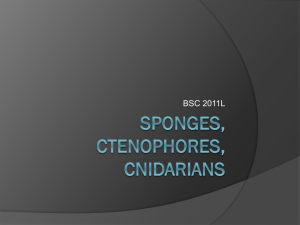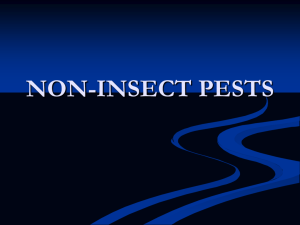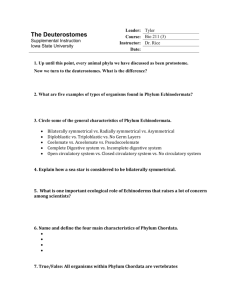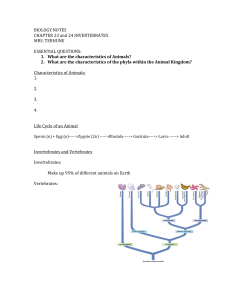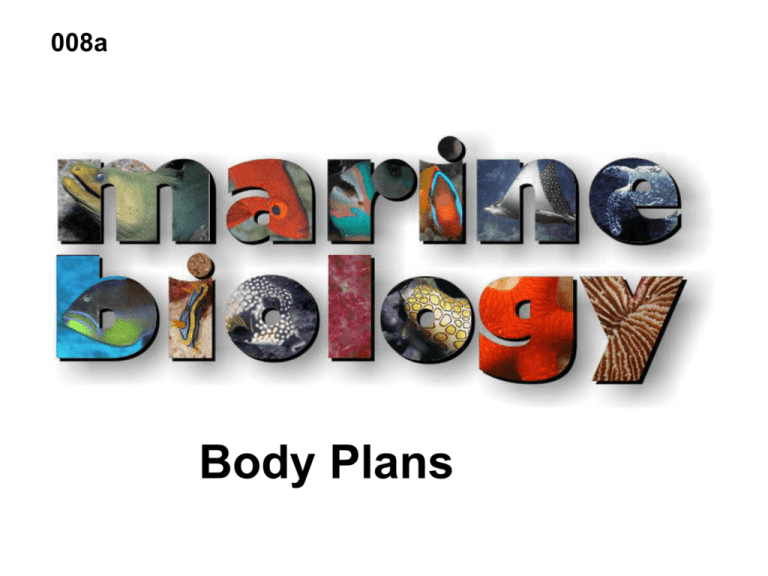
008a
Body Plans
The Animal Kingdom
Though there is great diversity in the animal kingdom, animals can
be distinguished from the other kingdoms by a set of
characteristics. Though other types of life may share some of
these characteristics, the set of characteristics as a whole
provide a distinction from the other kingdoms.
1. Animals are multicellular.
2. Animals are heterotrophic, obtaining their energy by
consuming energy-releasing food substances.
3. Animals typically reproduce sexually.
4. Animals are made up of cells that do not have cell
walls.
5. Animals are capable of motion in some stage of their
lives.
6. Animals are able to respond quickly to external stimuli
as a result of nerve cells, muscle or contractile tissue,
or both.
Animal Body Plans
Criteria for Evolutionary
Development & Classification
Cellular organization
Symmetry
Coelom
Digestive system
Segmentation
Cephalization
Kingdom Animalia
Symmetry
Unorganized
Radial
Bilateral
Cellular organization
Tissues, organs, systems
Kingdom Animalia
coelom
digestive tube
Coelom
Body cavity or not
Digestive system
None, 1 or 2 openings, how
Kingdom Animalia
Segmentation
Repetition of body parts
Cephalization
Development of a “head end”
Phylogentic Relationships of Animals
Platyhelminthes
Porifera
Mollusca
Cnideria
Nematoda
Arthropoda
Annelida
Echinodermata
pseudo
coelom
segmentation
acoelom
Protostome:
schizocoelem
Deuterostomes:
eucoelom
radial symmetry
bilateral symmetry
no true tissues
true tissue
Ancestral Protist
Chordata
Early
Embryonic
Development
of an Animal
Major Stages of Animal
Development
• gametogenesis
• fertilization
• cleavage
• blastula
• gastrulation
• differentiation and morphogenesis
Hypothetical Scheme for the Origin
of Multicellularity in Animals
Protostome vs Deuterostome
Blastula
Blastopore
• Protostome:
blastopore becomes mouth
• Deuterostome:
blastopore becomes anus
What is a Phylum?
Some Examples of Animal Phyla
• Phylum Cnidaria
– sea anemones, corals, jellyfish, man-of-wars & hydroids
• Phylum Mollusca
– snails, slugs, chitons, clams, oysters, octopods & squids
• Phylum Arthropoda
– spiders, scorpions, crabs, shrimp, insects & centipedes
• Phylum Echinodermata
– sea stars, sea urchins, sea cucumbers & sea lilies
• Phylum Chordata
– sea squirts, fish, amphibian, reptiles, birds & mammals
Major Body Plan
Characteristics of Animals
•
•
•
•
•
•
•
•
•
Symmetry
Primary Germ Layers
Gut Organization
Body Cavity
Segmentation
Skeletal Systems
Circulatory Systems
Appendages
Coloniality
Symmetry
• Asymmetry
• Radial Symmetry
• Bilateral Symmetry
Symmetry
Radial Symmetry
Bilateral Symmetry
Radial Symmetry
Jellyfish
Phylum Cnidaria
Pentamerous Radial
Symmetry
Sea Stars
Phylum Echinodermata
From The World Book (TM) Multimedia Encyc lopedia (c) 1999 World Book, Inc., 525 W. Monroe, Chicago, IL 60661. All
rights reserved.
Bilateral Symmetry
Slug
Phylum Mollusca
From The World Book (TM) Multimedia Encyc lopedia (c )
Bilateral Symmetry
Squid
Phylum Mollusca
From The World Book (TM) Multimedia Encyclopedia (c) 1999 World Book, Inc., 525 W.
Monroe, Chicago, IL 60661. All rights reserved.
Primary Germ Layers
Mesoderm
• None
• Diploblastic
• Triploblast
gut
Ectoderm
Endoderm
Fates of the Primary Germ Layers
• Ectoderm
– hair, nails, epidermis, brain, nerves
• Mesoderm
– notochord (in chordates), dermis, blood
vessels, heart, bones, cartilage, muscle
• Endoderm
– internal lining of the gut and respiratory
pathways, liver, pancreas
The
Formation of
Primary
Germ Layers
The
Formation of
Primary
Germ Layers
Germ Layer Patterns
Endoderm
Diploblastic
gut
Ectoderm
Diploblastic- two germ layers
Phylum Cnidaria
Germ Layer Patterns
Mesoderm
Triploblastic:
3 germ layers
gut
Ectoderm
acoelomate
Endoderm
Gut Organization
• No Gut
• Blind Sac Gut
• Complete Gut
No Gut
Sponges
Phylum Porifera
No Gut
Sponges
Phylum Porifera
Blind Sac Gut
Phylum Cnidaria
Complete Gut
Segmentation
Segmentation
Centipede
Phylum Arthropoda
From The World Book (TM) Multimedia Ency clopedia (c) 1999
Segmentation
Lobster
Phylum Arthropoda
Skeleton
Functions of the Skeleton
• supports basic body form
• protection of soft internal
tissues and organs
• facilitates locomotion
Skeleton
• Hydrostatic Skeletons
• Hard Skeletons
– Exoskeletons
– Endoskeletons
Hydrostatic
Skeleton
Sea Anemone
Phylum Cnidaria
Hydrostatic Skeleton:
• A non compressible fluid held under
pressure in a closed body
compartment.
• Uses antagonistic muscles for
movement.
• The gastrovascular cavity of the jellyfish
acts as hydrostatic skeleton against
which contractile cells can work.
Hydrostatic
Skeleton
Earthworm
Phylum Annelida
Exoskeleton
Chiton
Phylum Mollusca
From The World Book (TM) Multimedia Ency clopedia (c) 1999 World
Exoskeleton
Stony Coral
Phylum Cnidaria
Endoskeletons
Vertebrates
Phylum Chordata
From The World Book (TM) Multimedia Encyclopedia (c) 1999 World Book, Inc., 525 W. Monroe, Chicago, IL 60661. All
rights reserved.
Types of Appendages
Functions of Appendages
• locomotion
• feeding
• sensory
• protection
Tentacles
Sea Anemone
Phylum Cnidaria
Jointed Appendages
Bee Appendages
Phylum Arthropoda
From The World Book (TM) Multimedia Encyclopedia (c) 1999 World Book, Inc., 525 W. Monroe, Chicago, IL 60661. All
rights reserved.
Circulatory Systems
Functions of Circulatory Systems
• transport of nutrients and metabolic
wastes
• maintains water and solute balance
• defense against pathogens
Circulatory System
• None (simple diffusion)
• Body Cavity Circulation
• Closed Circulatory System
• Open Circulatory System
No Circulatory System
Comb Jelly
Phylum Ctenophora
Circulation in a Moon Jellyfish
Phylum Cnidaria
Closed Versus Open
Circulatory Systems
Nervous Systems
Functions of Nervous systems
• integration of animal behavior
• processing and interpretation of
sensory information
• elicits external and internal
responses
Types of Nervous Systems
Coloniality
Coloniality
Coral
Phylum Cnidaria
Coloniality
Sea Fan
Phylum Cnidaria
From The World Book (TM) Multimedia
Coloniality
Man-of-War
Phylum Cnidaria
From The World Book (TM) Multimedia
Polymorphism in the
Portuguese Man- of-War



